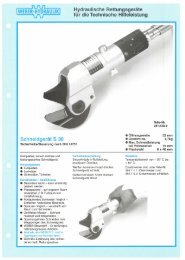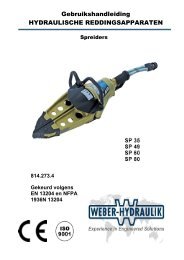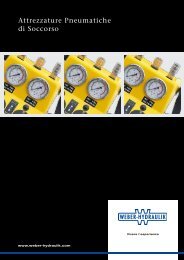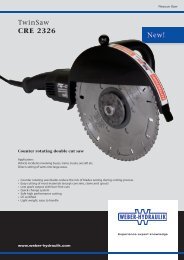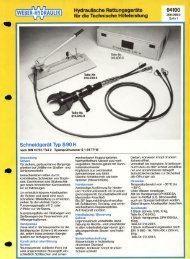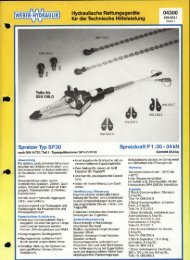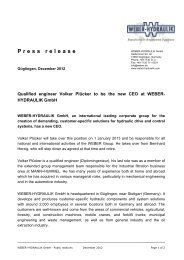Create successful ePaper yourself
Turn your PDF publications into a flip-book with our unique Google optimized e-Paper software.
�<br />
7 Construction of the system<br />
7.1 �ethod 1 (fixing round the A-column an windscreen)<br />
Hoo�� the tie belt with the mar��ing “1” on the top left or right with the flat �-hoo��<br />
into the D-shac��le�� la� it over the A-column and windscreen�� and hoo�� it in place on<br />
the other side. �ension the belt slightl� b� means of the belt camp.<br />
7.2 �ethod 2 (following remo�al of A-column and roof<br />
Hoo�� � of the unmar��ed tie belts with the flat �-hoo�� into the lower and upper<br />
D-shac��le�� feed to the front wheel rims and hoo�� the �-hoo�� into each rim. Align<br />
the lacquer canvas and tension all the tie belts.<br />
7.3 Security note�<br />
�e do not recommend the use of method 1 for con�ertible cars, and you should<br />
use method 2 instead.<br />
7.4 Even if the batter� has been disconnected�� leave the safet� device in place<br />
(tensioned) for at least one hour�� as there is a ris�� of automatic triggering of the<br />
airbag.<br />
7.5 �hen an OctopuS® passenger-airbag-retention-system has trapped an airbag<br />
wich has been triggered, it must be replaced because the material may ha�e<br />
stretched, e�en though this is not always �isible.<br />
8. Dismantling<br />
8.1 Dri�er-Airbag� Loosen the tension belt behind the steering wheel b� opening<br />
the loc��ing clamp and carefull� remove the belt webbing from the steering wheel<br />
Dismantling ( Passenger-Airbag)<br />
8.2 Passenger-Airbag� After the safet� period has expired�� release the belt<br />
clamps�� unhoo�� the �-hoo��s and flat �-hoo��s�� and carefull� remove the<br />
lacquer canvas from the interior of the vehicle.<br />
9. Care and maintenance<br />
9.1 Except from the case described above under �.� the �ctopu��� is reusable<br />
after each application. �he durabilit� amounts 1�� �ears.<br />
9.2 Protect the s�stem against heat and open flame�� chemicals�� petrol��<br />
oil and grease.<br />
9.3 For cleaning use onl� mild neutral household cleaning agent in the concentration<br />
recommended b� its manufacturer. Properl� dr� the s�stem after cleaning.<br />
9.4 Alwa�s store �our �ctopu��� in the complan bag provided in a dr� place<br />
and ��eep it awa� from heat sources (max. storage temperature ���°) and<br />
chemicals. Don’t store it without storage case so that it is not exposed to<br />
direct sunlight or other sources of ultraviolet light.<br />
10.Repair<br />
Hoo�� two of the unmar��ed tie belts with the flat ��-hoo�� into the D-shac��les�� feed it<br />
to the front wheel rims and hoo�� the �-hoo�� into the individual front wheel rims.<br />
Postition the lacquer canvas and tension all the tie belts.<br />
10.1 �he user is not allowed to carr� an� repair wor�� on the s�stem.<br />
Please contact �our authorized dealer.<br />
4. Emploi (airbag au �olante)<br />
4.1 Le �ctopu��� est conçu comme dispositif de protection contre un<br />
déclenchement incontrôlé du sac gonflable du conducteur arrivant après des<br />
accidents de la route. Emploi (antidéclencheur airbag)<br />
4.2 Emploi (antidéclencheur airbag)<br />
L’ anti-déclecheur �ctopu��� de l’airbag passager est un dispositif de sécurité<br />
en cas de déclenchement incontrôlé de l’airbag passager lors d’opérations de<br />
sauvetage postérieurs à un accident de la route.<br />
5. Description (airbag au �olante)<br />
5.1 Le s�stème �ctopu��� se compose de deux sangles tressées séparées pour le<br />
montage de volants de différents diamètres ��<br />
- pour diamètre du volant 3��� �� 3��� mm<br />
(couleur rouge)<br />
- pour diamètre du volant ����� �� ���� mm<br />
(couleur bleu)<br />
- pour diamètre du volant �3�� �� ����� mm<br />
(couleur vert)<br />
�haque sangle tressée comprend une plaque de sangles centrales<br />
(1)�� sur laquelle sont cousues en étoile huit sangles (2).<br />
La bande de serrage (3) avec boucle de tirage (�) sert à a fixation<br />
de la sangle tressée sur le volant. A l’aide d’une pince à<br />
sangles (�) à blocage automatique�� la bande de serrage est<br />
fixée après l’amarrage.<br />
5.2 Description (antidéclencheur airbag)<br />
Le s�stème est composé d’une bâche laquée �REVIRA�� à haute résistance<br />
avec un rubanage en pol�ester horizontal et un diagonal sur lesquels est<br />
respectivement cousu un arceau «D». La sangle identifiée «1»<br />
est constituée par le rubanage�� deux crochets «�»<br />
plats et d’un verrouillage.<br />
Les sangles sans identificiatif sont conçueues çueues ueues de de la<br />
la<br />
même ême me marnière marnière et et se se composent composent du du rubanage�� rubanage�� rubanage�� de<br />
de<br />
deux crochets «�»�� «�»�� �»�� »�� de deux crochets «�» «�» «�» «�» �» » plats plats et et d’un<br />
d’un<br />
verrouillage.<br />
6. Construction du système (airbag au �olante)<br />
6.1 Mesure préparatories<br />
6.1.1 Une couronne de volant déformée ne peut pas plus absorber en sécurité les<br />
forces qui se produisen lors d’un déclenchement éventuel du sac conflable et<br />
pour cette raison il faut la contrôler pour éviter des endommagements avant le<br />
montage de l’�ctopu���. Dans le cas d’endommagements visibles du volant�� le<br />
montage de l’�ctopu��� n’est pas permis !<br />
6.1.2 Assurer que le diamètre de l’�ctopu��� à monter correspond à la dimension du<br />
volant (voir page �.1).<br />
6.2 Placer les sangles tressées sur la couronne du volant et tirer la bande de<br />
serrage par la boucle de tirage à travers la pince à sangles derrière le volant.<br />
�entrer le s�stème de sangles sur le volant et le fixer en serrant aussi fort que<br />
possible la bande de serrage ; observer la position centrale à l’égard du volant<br />
/ sac gonflable !<br />
17





